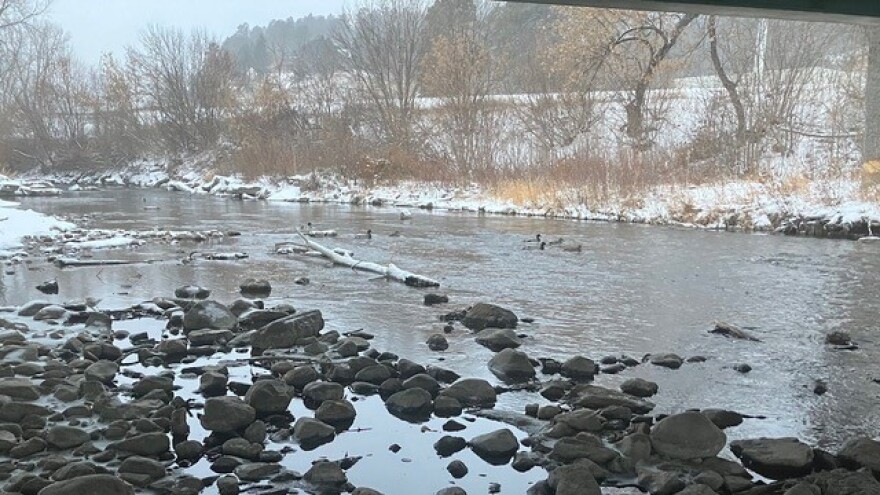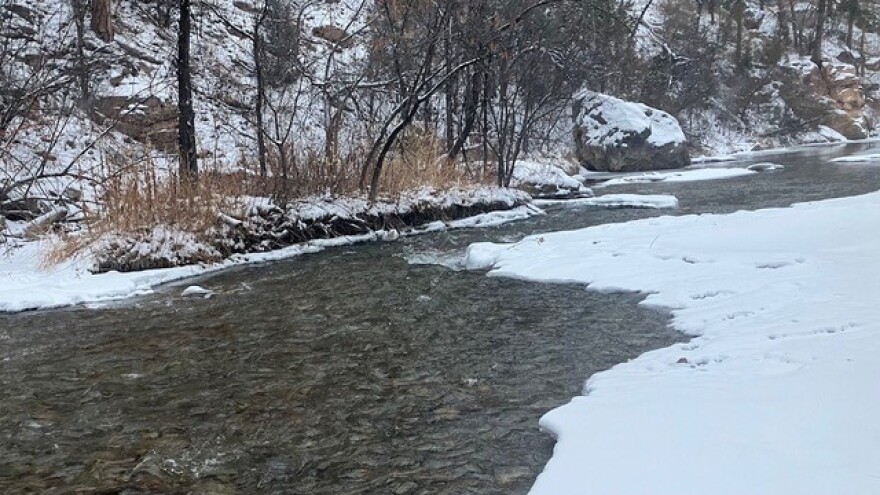It was an odd thing to be doing, I suppose, in the middle of a blizzard.
Or at least in the middle of what they were calling a blizzard, outside of town, at least, where the interstate was closed and snow carried by wind gusts topping 50 mph was blotting out vast stretches of the landscape.
Here in Rapid City, it was kind of snowy and kind of blowy and cold enough at 18 degrees, but something short of a blizzard by South Dakota standards. Even so, it was fairly unfriendly late Tuesday afternoon as I walked along Rapid Creek, examining the stream flow and thinking about trout.

I didn’t see anyone else out slogging along the creek. Who else would have been at that time in those conditions? But I wasn’t the only one thinking about the creek, the trout it supports and the trouble they might be in.
The trouble they almost certainly are in.
Before I get into that, though, a couple thoughts about the trout themselves.
First, they’re brown trout. Wild brown trout. Not fish born and reared in a hatchery and released into the stream. These wild brown trout are hatched from eggs laid in the creek by brown trout that were hatched from eggs laid in the creek by brown trout that were hatched from eggs laid, well, you know.
Wild.
Wild trout are special trout, to me and to many others. Nothing against stockers. They’re fun. They’re necessary. They provide lots of fishing for kids of all ages in lakes and streams throughout the Black Hills and beyond. And they’re plenty good to eat. I am fond of them. I wish them well.
But stocked trout are pretty much transactional creatures. You put money into your fishing license and into your federal excise taxes on the fishing gear you purchase, wildlife agencies put some of that money into hatcheries and hatcheries produce trout.
Ka-ching.
It’s a good thing, mostly.
They make a living on their own, if we give them a chance
But there’s a difference between those fish and wild trout. Wild trout are something else, something strong and beautiful and in their own slick-finned ways mysterious, something to be admired, to be cared for, to be worried about.
And, if at an emotional level you’d like to take it as far as I like to take it, wild trout are something to be loved, as wild things should be loved.
Not just the fish themselves, but the idea of the fish. The idea of self-sustaining brown trout living right among us in a clear-water creek that curls and creeps and burbles its way through South Dakota’s second-biggest city.
Oh how I love that wild idea and the trout that support it. They make a living on their own, pretty much, if we give them a chance, if we don’t get in their way. And by sustaining themselves, do they not also help sustain something wild and important in us? I think so.
That’s why I was out along the creek in wintry conditions that some — like, say, some who live in Mesa or San Bernardino or Fort Worth — might consider a roaring blizzard, slogging through the snow, studying the stream flow, wondering and worrying about the trout.
If the timing seems illogical, believe me when I say I had my reasons. Good reasons. Most of them were included in a fascinating public-radio discussion led by my friend and colleague Lori Walsh earlier in the day on her In the Moment program.
It was all about Rapid Creek flows and Rapid Creek brown trout, and how sharply reduced flows out of Pactola Dam at the wrong time might well have destroyed eggs that were laid and fertilized this fall. Rainbow trout spawn in the late winter and early spring. But brown trout spawn in the late fall and early winter.
And for that spawn they need shallow, gravelly stretches of creek with reliable flows of clean, well-oxygenated water throughout the spawn and into the hatch, a process that takes weeks.
The flows in Rapid Creek were anything but reliable for a time lately, and anything but good for the trout.
Lori’s program wasn’t the first coverage this issue has received. Among the other sources, my friend Joshua Haiar, who recently moved from South Dakota Public Broadcasting to the new news website South Dakota Searchlight, did an excellent piece on the problem.
But news is best when it’s presented in multiple formats. And radio literally puts the voice or voices to issue that matter. Few places on radio do it as well as public radio, and Lori’s In the Moment Show in particular.
A radio review of a sad story and threat to wild browns
In this case, Lori had a radio conversation with my friend and fly fishing mentor, Hans Stephenson, owner of Dakota Angler & Outfitter here in Rapid City. Then she interviewed Crystal Lesmeister, a civil engineer for the federal Bureau of Reclamation.
Those two educated voices and Lori’s deft guidance through their interviews gave a pretty good picture of a worrisome story about the creek.
If you follow the news, you might already know that the Bureau of Reclamation, which in cooperation with the city of Rapid City manages stream flows out of Pactola Reservoir, recently found problems with a water-release gate in the dam.
They were problems that needed fixing, soon. And problems with dams, especially those upstream from clusters of rural residents and a small city, are problems to take seriously and fix soon. I understand that. Most reasonable people do.
Fixing the problems at the dam caused another problem, however, when flows from the dam had to be diverted through a pipe that was much smaller than the release gates. So flows into Rapid Creek below the dam dropped to about 11.7 cubic feet per second, or about half of what has been the minimum winter flow needed to sustain the wild brown trout.
Beyond that, part of the water flowing in the creek disappears underground just upstream from Rapid City when it hits a limestone loss zone. So the flow of the creek as it reached town was even lower than 11.7 cfs.
The creek gets a surface-water boost from natural springs flowing into it in town. Which helps a little. But by then much of the damage was likely done.
The repairs lasted longer than expected, meaning the low flows continued for eight days. That left some key spawning areas for the wild brown trout short on water or even out of the water entirely.
“We don’t know the long-term effect,” Stephenson told Lori. “But we definitely have pictures of areas that were active spawning areas from late October, that were high and dry. So very likely those eggs and the fish that would have hatched from those eggs are gone.”
And how do we make sure it doesn’t happen again?

And some winter temperatures with lows in single digits added to icing on the creek, which takes away more refuge areas for the trout. Did all of that mean some first-year trout and even some older adults died? Maybe. We don’t know, yet.
Lesmeister, a civil engineer for the Bureau of Reclamation, explained the dam problem and the repair during her radio interview with Lori. And I give Lesmeister credit for going on the radio to talk about a difficult situation. Not everyone would do that.
After explaining the problem with the damaged water-control gate, Lesmeister admitted that the bureau could have handled things better.
“I think we could have done a better job communicating that we had this planned and roughly how long it would have taken to repair,” she said.
That’s part of it. Understanding helps. But there has to be a better way to handle repairs that have been needed before and will likely be needed again. And that way should not create such a potentially damaging disruption of flows during a crucial time of year for wild brown trout.
I hope this failure in the process is a lesson that will lead to change and prevent such an unfortunate reduction in flows in the future.
It will likely be spring before we’ll begin to see whether adult trout were lost. And it will be longer than that before we understand the impact on the eggs laid this year.
“That’s the hardest part right now is waiting to see what happened,” Hans told Lori. “We have to assume there’s some impact.”
To mitigate that impact, Hans recommends that those of us who fish Rapid Creek pretty much year round — including winter days when it warms up enough to be tolerable — leave the trout alone for a while.
They’ve had enough stress from the low flows.
I try to fish Rapid Creek here in town at least one of two days every month. It is a particular kind of thrill to catch and release a wild brown trout a five-minute drive from my front step on a 45-degree day in December or January. In South Dakota.
But I’m going to give that up for a while, as Hans suggests.
I’ll still go to the creek regularly, of course. But instead of slinging a tiny fake fly out onto the water, I’ll be casting my hope for the fish and their future.
And that I can do on any day at all, even during a bit of a blizzard.


